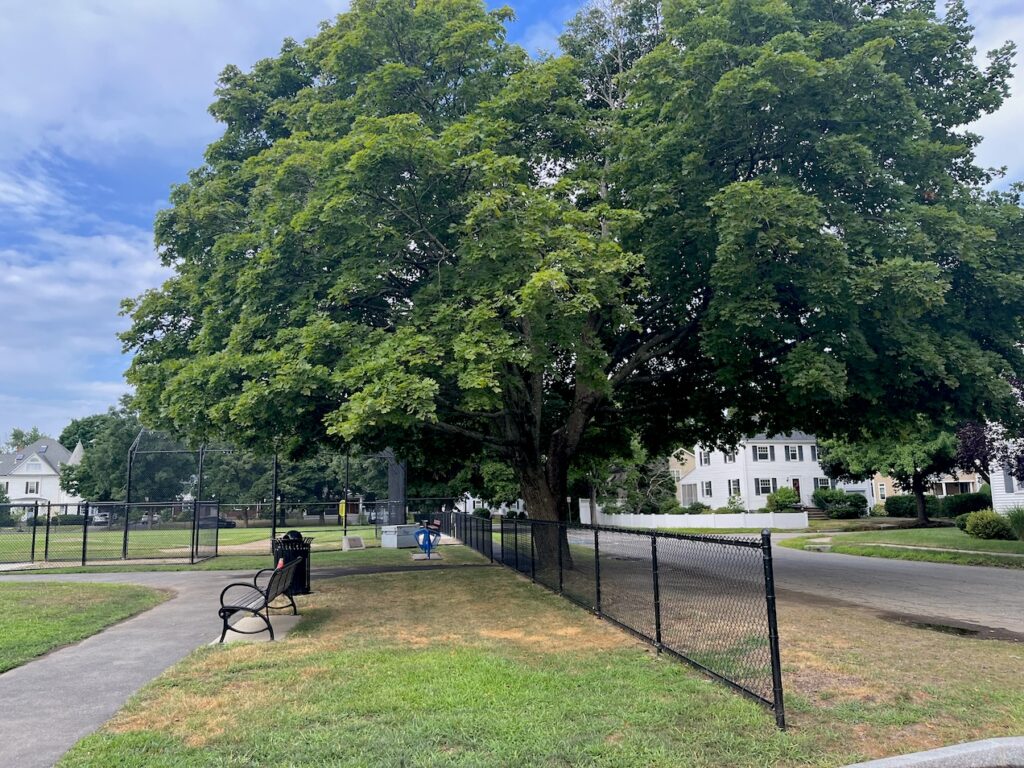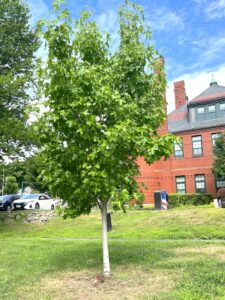By Vicki Amalfitano, Lucia Gates, Eva Hoffman, and Adam Howe
What makes you feel at ease when you drive down a town street? Would it be as comfortable on a hot summer’s day without shade trees? Tall, beautiful oak, maple, and birch trees; magnificent beech trees, flowering dogwood, magnolia, and cherry trees enrich our streets and yards. They fill our senses with their beauty, and they cool our homes. They take in the carbon dioxide we breathe out, and they release the oxygen we breathe in. We are grateful for the trees’ benefits and their positive impact on the value of our homes.
One crucial benefit the trees provide is not so obvious. Every mature oak supports more than 900 varieties of insects, from ants to caterpillars to beetles. All this rich insect life, in turn, supports a rich bird environment. And while we admire the birds perhaps more than the hordes of small mammals—mice, chipmunks, squirrels, rabbits—they are all part of the food chain that supports our biome. And they all need native trees.
Beautiful though they may be, exotic imports such as katsuras, zelkovas, and ginkgoes support a very impoverished insect life. And some imports, such as Bradford pears, Norway maples, and Trees of Heaven (Ailanthus), are invasive trees. They literally drive out the native plant life.
History of the Belmont Shade Tree Committee
Belmont is one of 90 Massachusetts towns designated as a Tree City USA by the Arbor Day Foundation. Among the criteria for this designation is that a town employ a certified tree warden and establish an advisory committee to support the town’s professional forestry management efforts.
In Belmont’s case, this tree committee is not a policy or decision-making body. Instead, the committee advises and supports the town’s tree warden, who is ultimately responsible for forestry management decisions. Additionally, the Tree Committee is involved in community outreach programs and efforts to promote tree plantings and general awareness of the town’s forestry efforts and best practices. Established in 1983, Belmont’s Shade Tree Committee is composed of nine Belmont residents who are appointed to three-year terms by the town Select Board. Belmont’s long-standing former tree warden, Tom Walsh, says that the committee’s value is keeping trees on the town’s agenda. He also addressed the value of an independent, objective committee.
This committee is guided by a charge from the Select Board, which outlines the committee’s responsibilities and goals. These include reviewing current vegetation and tree practices and recommending annual priorities and plans for planting and maintaining Belmont’s trees.
The Tree Inventory
If you go online to the Department of Public Works web page, you will find a very useful tool, the Belmont Tree Inventory, available at bit.ly/BCF-Tree-Inventory. This list contains a species breakdown as well as the total number of town trees, which is very useful for seeing the overall picture of trees in Belmont. This list includes trees in parks, cemeteries, schools, public lands, and street trees but not trees on private or conservation land. The town tree wardens use this list to monitor trees, plan for future plantings, consult with the Shade Tree Committee, and prepare budgets. The Department of Public Works (DPW) continuously updates it.
The first thing you will notice is that Belmont has a variety of trees. But as you look at the details, you will see that while there are many species with only a few trees, other species are widely planted.
For example, there are 3,437 maple trees, but only 642 oak trees. Of those maples, a preponderance are Norway maples. While Norway maples are beautiful trees, they are also aggressively invasive; the town no longer plants this species.
Other common trees which are no longer planted because they are alien species include ginkgoes (151), zelkovas (160), Callery pears (217), and katsuras (73). We can enjoy them, and we will not remove them just because they are alien. But for now, we won’t plant new ones.
The Notable Tree list
The Shade Tree Committee has a long-standing tradition of maintaining a list of Belmont’s Notable Trees, available at bit.ly/BCF-Notable-Trees. With connections to the Arnold Arboretum and Harvard University, Belmont has planted many exotic and unusual trees in past years. To honor these trees, the committee recently updated this list on the town website. This list can be used for an informative ride through Belmont, visiting each beautiful tree as you circle throughout town.
The Preferred Trees List
The committee has another helpful tool for residents and contractors; the Preferred Tree list, available at bit.ly/BCF-Preferred-Trees. The list includes native trees and shrubs suitable for public and private plantings in Belmont. The committee was guided by current Belmont DPW Director and former interim Belmont tree warden Jay Marcotte’s favorite saying, “The right tree for the right place.”
The Commemorative Shade Tree Planting Program
The Commemorative Shade Tree Planting Program allows private residents, groups, and businesses to sponsor the planting of a town tree. Such trees not only beautify Belmont, but they can also be used to recognize individuals, groups, or events on a commemorative plaque in the town hall. A contribution of $500 pays for the tree and its planting and maintenance. The town will be responsible for caring for and maintaining all trees planted under this program. Detailed information about this program can be found online at bit.ly/BCF-Comm-Trees or at the Department of Public Works at 19 Moore Street.
The Shade Tree Committee’s Advisory Roles
The Shade Tree Committee’s formal charge is “to review the current tree and vegetation practices, stay advised of the town tree budget, and make recommendations. The committee shall recommend annual priorities, long-range plans, and maintenance regarding plantings on public land to the Select Board and Town Meeting.”
Armed with the intelligence from its recently developed Preferred Tree List of native species suitable for planting in Belmont, the Shade Tree Committee has increased its outreach and advisory role to the landscape components of town projects. The committee met in April with Stimson Design, the landscape design company for the new Belmont Library. The Shade Tree Committee members weighed in on the tree and shrub recommendations, offering suggestions on increasing native species, and advocated for protecting the current mature trees along Wellington Brook behind the site during the two-year construction period.
Shade Committee members have met with Holly Muson, chair of the Community Path Project Committee, on its landscape plan to review and support the selection of native species. That meeting was an integral part of the community input process, as the long-awaited path is nearing the end of the 75% design process for Phase I.
In addition to these new building projects, the Shade Tree Committee has reviewed and approved new tree plantings in the old Belmont Cemetery, focusing on native species from the committee’s Preferred Tree List. Shade Tree Committee Chair Eva Hoffman assigns a committee member as liaison to each town project that involves tree and shrub plantings to ensure that these projects benefit from the committee’s resources and talent.
Belmont’s New Tree Warden
The Shade Tree Committee works closely with the town to optimize the number and health of shade trees on public land, thereby enhancing the beauty and benefits trees provide to Belmont residents. The Committee enjoys the support and input of Belmont’s Department of Public Works staff, especially the town’s tree warden.
After the retirement of long-time tree warden Tom Walsh in July 2021, the warden post had been vacant. DPW Director Jay Marcotte acted as interim tree warden with Mike Santoro, a DPW staff member for over 40 years, assisting in the field. During the past year, Santoro completed training to be certified by the state to hold the position. People who successfully complete the six-module Massachusetts Qualified Tree Warden (MQTW) training course receive the MQTW designation required to hold the position of tree warden.
Santoro described his goals as Belmont’s new tree warden as “staying on top of maintaining the Town’s trees, street trees or on town property, and maximizing resources to increase the number of trees in Belmont.” He said, “Ideally, we would plant a new tree to replace each older and diseased tree that needs to come down in any given year, but we don’t have the resources for that.” Santoro lauded the Commemorative Shade Tree Program as one way Belmont residents can simultaneously donate a tree to a public space and honor someone.
Vicki Amalfitano, Lucia Gates, Eva Hoffman, and Adam Howe are members of the Shade Tree Committee.




Sorry, the comment form is closed at this time.